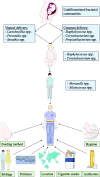The Microbiome of the Nose-Friend or Foe?
- PMID: 32206384
- PMCID: PMC7074508
- DOI: 10.1177/2152656720911605
The Microbiome of the Nose-Friend or Foe?
Abstract
Recently, multiple studies regarding the human microbiota and its role on the development of disease have emerged. Current research suggests that the nasal cavity is a major reservoir for opportunistic pathogens, which can then spread to other sections of the respiratory tract and be involved in the development of conditions such as allergic rhinitis, chronic rhinosinusitis, asthma, pneumonia, and otitis media. However, our knowledge of how nasal microbiota changes originate nasopharyngeal and respiratory conditions is still incipient. Herein, we describe how the nasal microbiome in healthy individuals varies with age and explore the effect of nasal microbiota changes in a range of infectious and immunological conditions. We also describe the potential health benefits of human microbiota modulation through probiotic use, both in disease prevention and as adjuvant therapy. Current research suggests that patients with different chronic rhinosinusitis phenotypes possess distinct nasal microbiota profiles, which influence immune response and may be used in the future as biomarkers of disease progression. Probiotic intervention may also have a promising role in the prevention and adjunctive treatment of acute respiratory tract infections and allergic rhinitis, respectively. However, further studies are needed to define the role of probiotics in the chronic rhinosinusitis.
Keywords: allergic rhinitis; chronic rhinosinusitis; dysbiosis; microbiome; microbiota; nose; probiotics.
© The Author(s) 2020.
Figures
Similar articles
-
Effects of nasopharyngeal microbiota in respiratory infections and allergies.Clin Exp Pediatr. 2021 Nov;64(11):543-551. doi: 10.3345/cep.2020.01452. Epub 2021 Apr 15. Clin Exp Pediatr. 2021. PMID: 33872488 Free PMC article.
-
Anterior Nares Diversity and Pathobionts Represent Sinus Microbiome in Chronic Rhinosinusitis.mSphere. 2019 Nov 27;4(6):e00532-19. doi: 10.1128/mSphere.00532-19. mSphere. 2019. PMID: 31776238 Free PMC article.
-
Current advances on the microbiome and role of probiotics in upper airways disease.Curr Opin Allergy Clin Immunol. 2020 Feb;20(1):30-35. doi: 10.1097/ACI.0000000000000604. Curr Opin Allergy Clin Immunol. 2020. PMID: 31789894 Review.
-
Nasal Microbiome and Its Interaction with the Host in Childhood Asthma.Cells. 2022 Oct 7;11(19):3155. doi: 10.3390/cells11193155. Cells. 2022. PMID: 36231116 Free PMC article. Review.
-
Novel microbiome-based therapeutics for chronic rhinosinusitis.Curr Allergy Asthma Rep. 2015 Mar;15(3):504. doi: 10.1007/s11882-014-0504-y. Curr Allergy Asthma Rep. 2015. PMID: 25777787
Cited by
-
Influence of the Microbiome on Chronic Rhinosinusitis With and Without Polyps: An Evolving Discussion.Front Allergy. 2021 Oct 1;2:737086. doi: 10.3389/falgy.2021.737086. eCollection 2021. Front Allergy. 2021. PMID: 35386978 Free PMC article. Review.
-
Chronic Rhinosinusitis and Alzheimer's Disease-A Possible Role for the Nasal Microbiome in Causing Neurodegeneration in the Elderly.Int J Mol Sci. 2021 Oct 18;22(20):11207. doi: 10.3390/ijms222011207. Int J Mol Sci. 2021. PMID: 34681867 Free PMC article. Review.
-
Composition of nasal bacterial community and its seasonal variation in health care workers stationed in a clinical research laboratory.PLoS One. 2021 Nov 24;16(11):e0260314. doi: 10.1371/journal.pone.0260314. eCollection 2021. PLoS One. 2021. PMID: 34818371 Free PMC article.
-
Maternal constipation is associated with allergic rhinitis in the offspring: A nationwide retrospective cohort study.PLoS One. 2023 Oct 5;18(10):e0292594. doi: 10.1371/journal.pone.0292594. eCollection 2023. PLoS One. 2023. PMID: 37797074 Free PMC article.
-
Effects of intranasal administration with a symbiotic strain of Bacillus velezensis NSV2 on nasal cavity mucosal barrier in lambs.Vet Res Commun. 2024 Nov 20;49(1):21. doi: 10.1007/s11259-024-10596-6. Vet Res Commun. 2024. PMID: 39565462
References
Publication types
LinkOut - more resources
Full Text Sources


